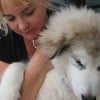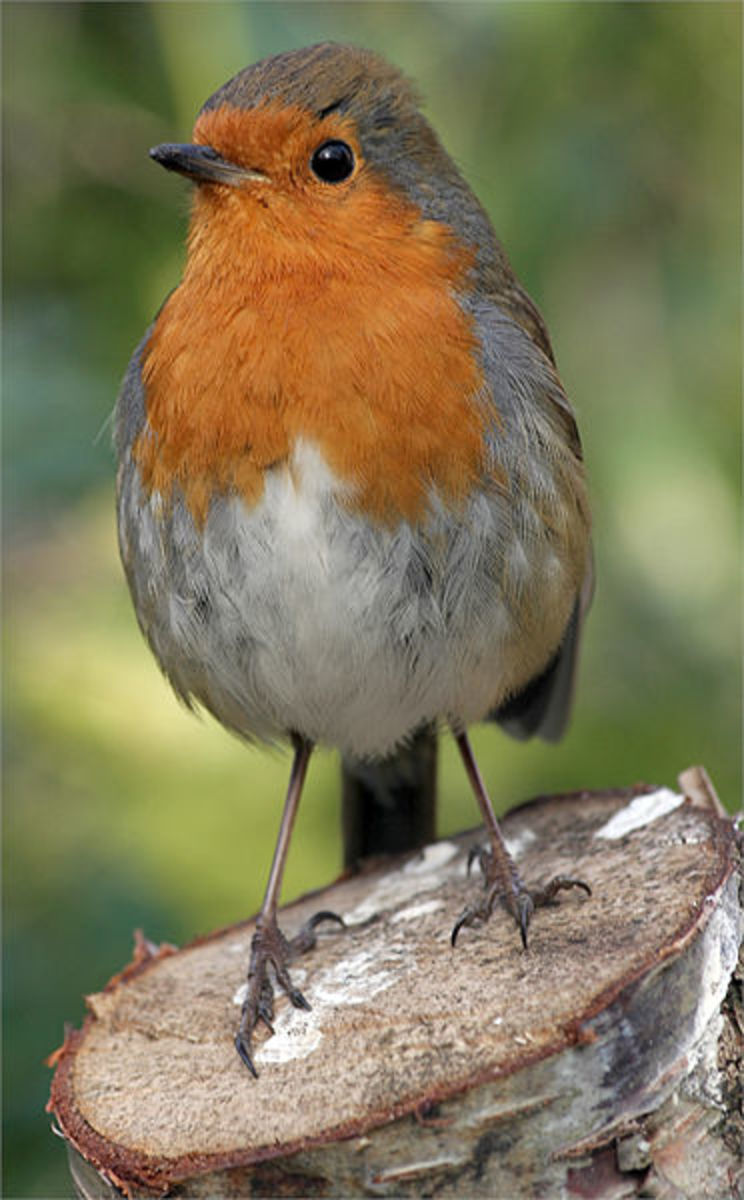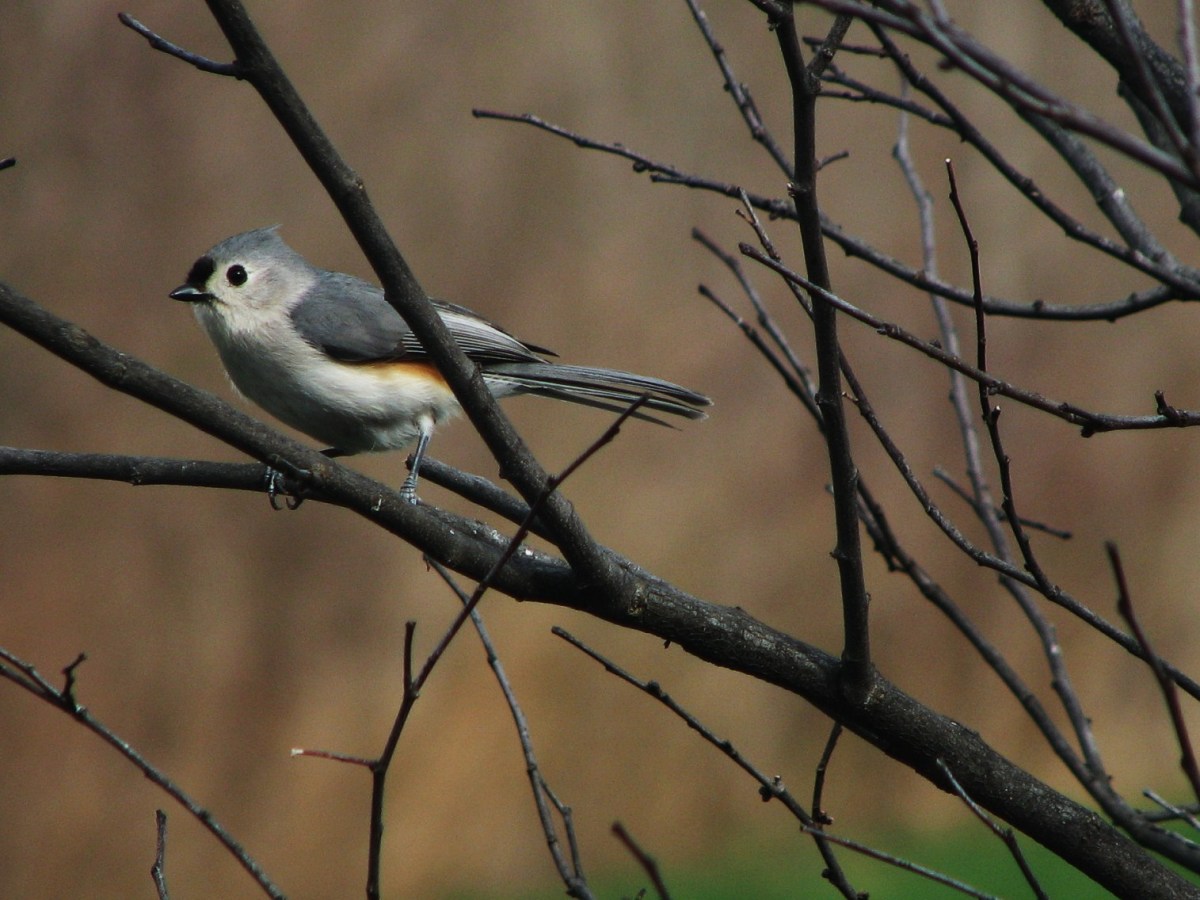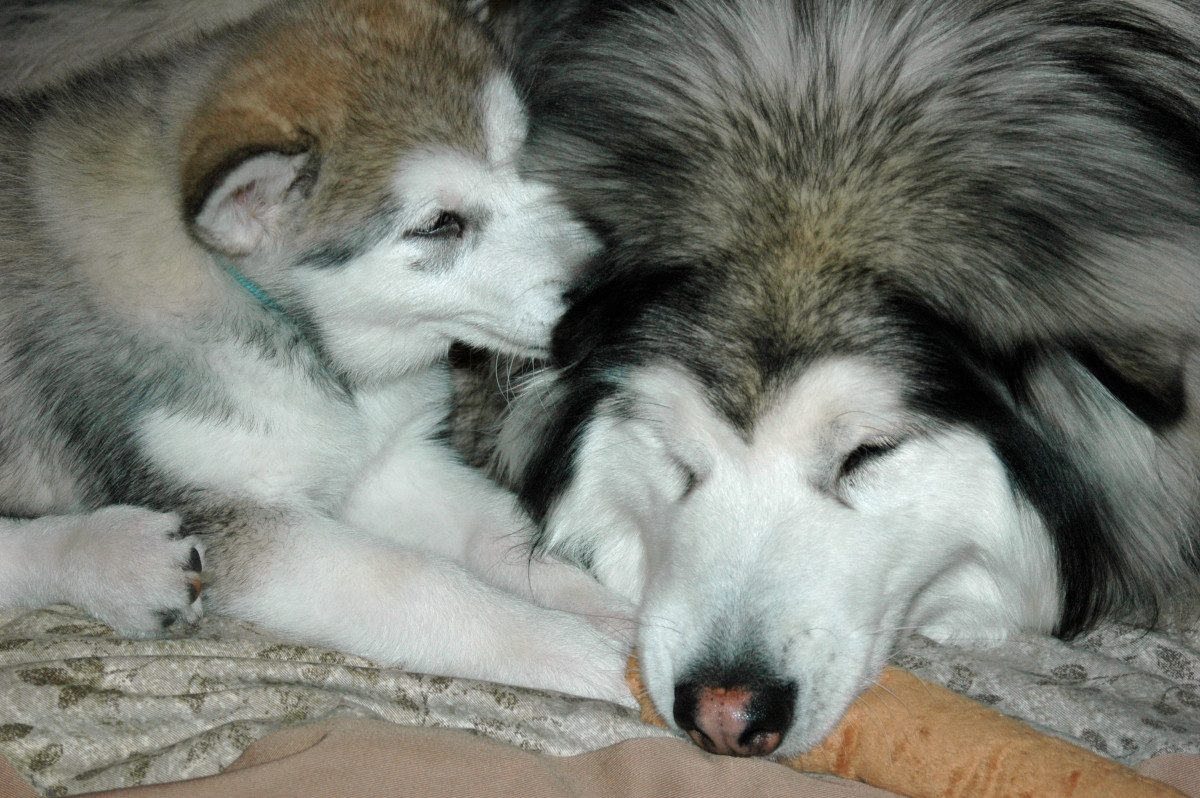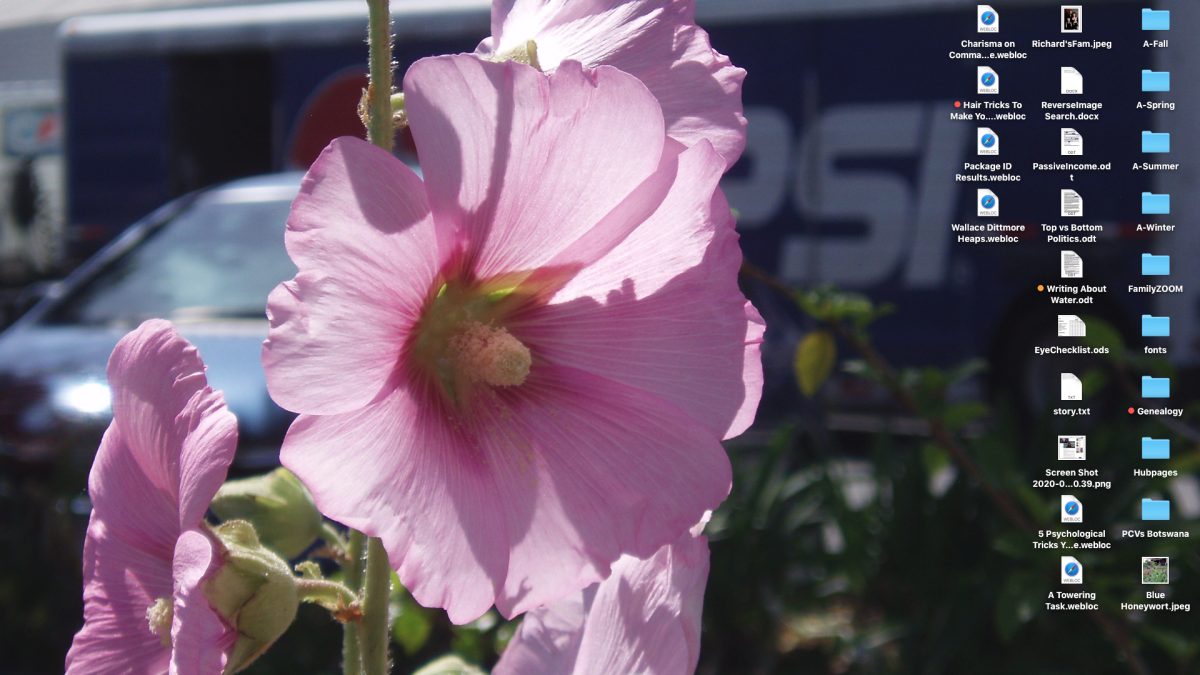Bird Photos Great Blue Heron Preening
BIRD PHOTOGRAPHY
Anyone who knows me, knows that I love bird photography. Unfortunately, I don't have the best camera for this hobby though I do try to make the most of what I have.
On a recent walk and training session down by the Ochoco Creek in my hometown of Prineville, Oregon, I was just heading back to the car with my dogs when I thought I'd take a peek over the bridge and see if there just might be a Great Blue Heron fishing.
I was thrilled to see that as the sun faded in the late afternoon sun, there he or she was, fishing at first just off the edge of the creek. Sending my dogs on with my husband, I whipped out the only camera I had on my person to document this wonderful site, my Nikon CoolPix.
For more pictures including nesting Great Blue Herons, visit my photography website at centraloregonphotos.com.
_________________________________________________________________
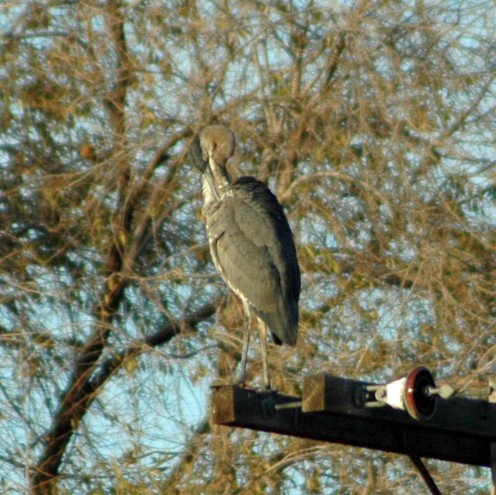
Unfortunately, I was too far away to do the bird justice. It was a spectacular little slice of time that I stood there watching him fish first from the shore, then finally diving into the water and swimming like a duck. I have posted that picture on here as well just because it was such an interesting thing to see. I had read about Great Blue Herons swimming but had never actually seen one doing it!
Hoping against hope that my pictures would be sufficient to enlarge them but happy that I had at least seen one of my favorite birds fishing in such a tranquil setting, I headed for the car to catch up with my husband and the dogs. Just as I began to leave, my fine-feathered friend took off and decided to sit atop the nearest telephone pole to begin his preening behaviors.
I literally ran back to the car, grabbed my more powerful SLR Nikon and drove back to the parking lot as fast as I could. What ensued was a full hour's worth (at least) of watching this young Great Blue Heron go through all the gyrations of his preening behavior.
I started out quite far away and was able to advance slowly and cautiously ever closer to him until I was some ways away from him but shooting up against the sky. He did not seem to be bothered by my maneuvering as he never went to an erect posture except to preen.
It was a fantastic experience and one I will never forget. I only wish I had gotten better pictures of him flying off his perch or that I could have stood there longer. I did not use a tripod so it is a miracle that my 200 pictures all came out almost to a one without motion artifact.
I did return about 5 days later and think it probably was the same bird sitting atop the telephone pole. He again took off though before I was ready though I caught some of him flying. I go back every day or so to try and recapture him again as he seems to routinely visit the creek at this spot and also this particular telephone pole!
_________________________________________________________________
GREAT BLUE HERON SWIMMING RIGHT BEFORE PREENING
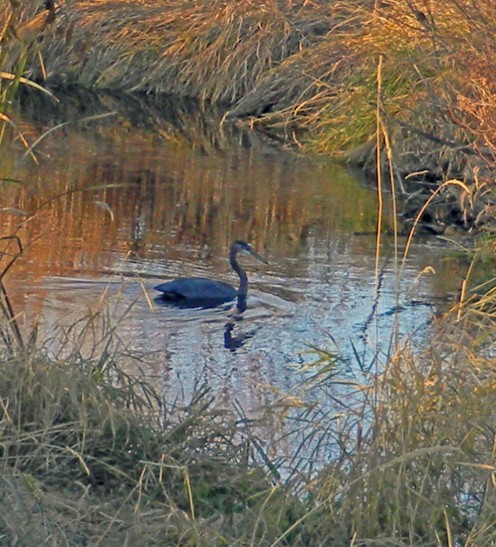
_________________________________________________________________
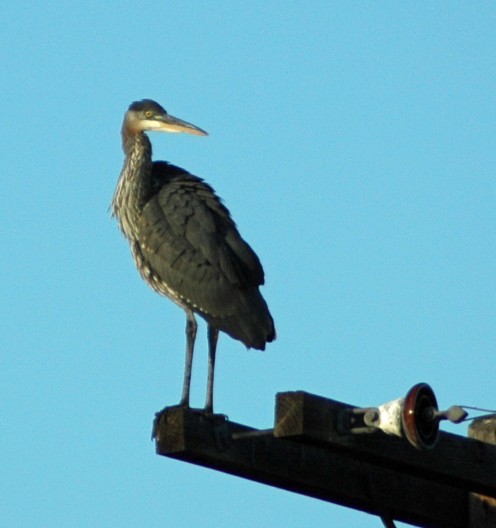
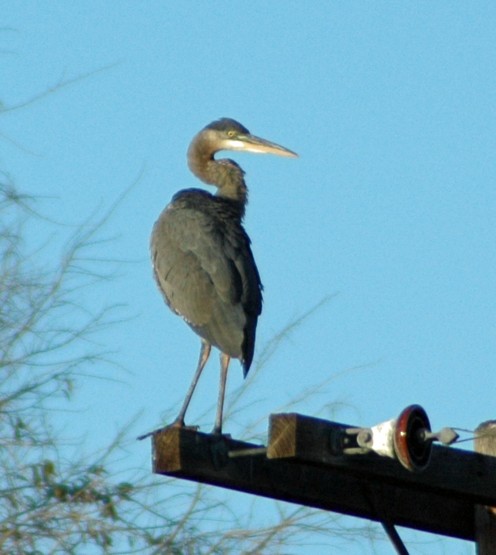
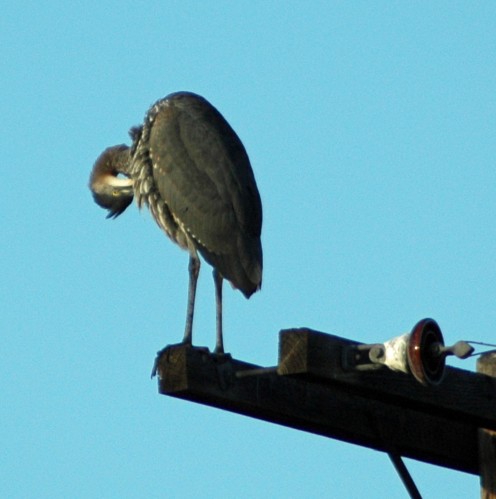
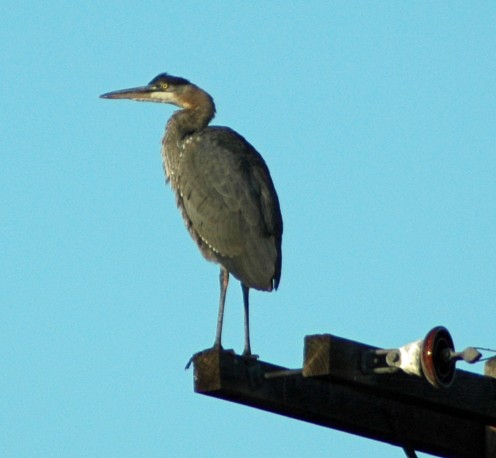
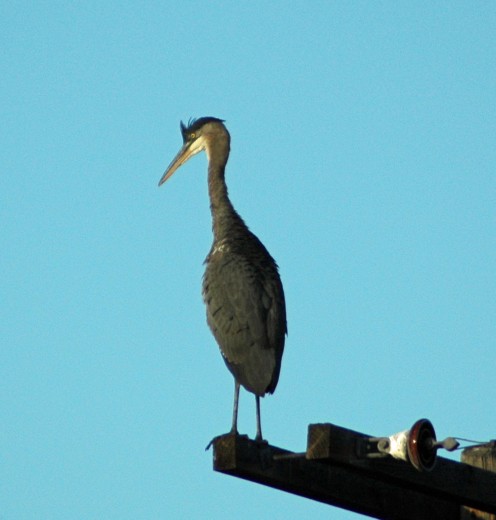
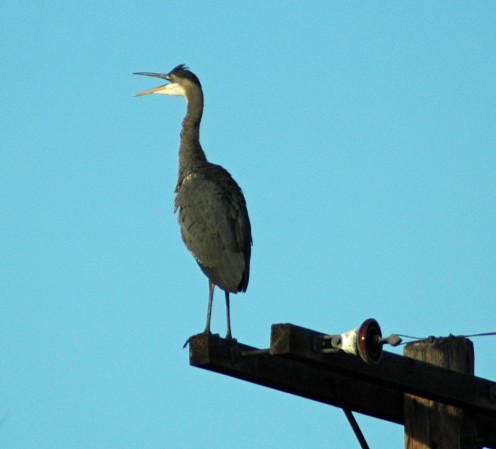
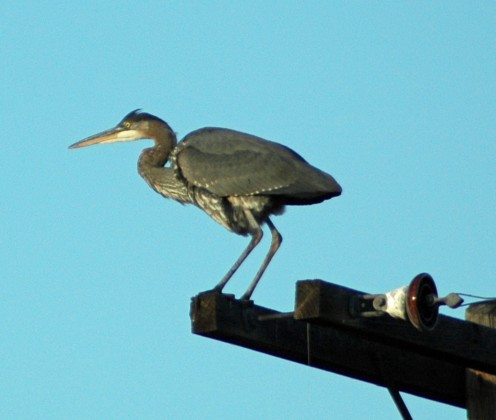
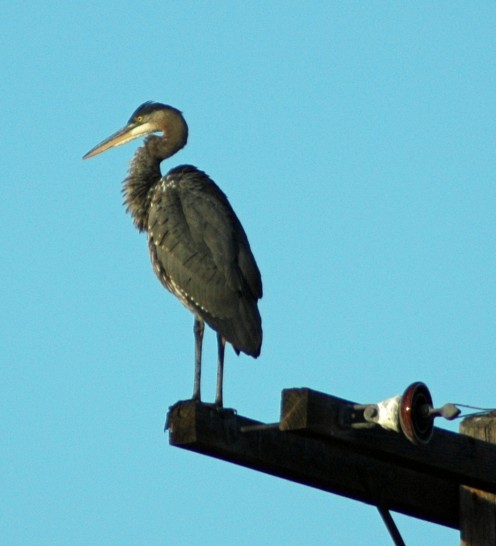
ABOUT THE GREAT BLUE HERON
For those of you who do not know much about this magnificent bird, let's review some of the particulars that makes this bird so unique.
- Great Blue Herons generally reach about 4-1/2 feet in height and are the largest heron in North America
- They have a wingspan of at least 6 feet, usually closer to 6-1/2 feet or more
- For such a huge wingspan, they remarkably only weigh between 5 and 8 pounds
- Males are generally indistinguishable from females
- They are almost prehistoric in their appearance with huge beaks, long, long legs and gigantic wings
- Great Blue Herons are distinguishable as they fly by the slow, long flaps of their wings as they cover great distances quickly usually clocked at about 20-30 mph
- It is thought that herons date back to the 18th century
- If a Great Blue Heron survives its first year of life, it can live to be 15 years old but the average is about 8 or so
- Great Blue Herons are monogamous during the year of their breeding but will seek out a new partner the following year unless they found the relationship mutually rewarding
- Adults have the shaggy ruff at the base of their throat - that's what makes me think Henri is a youngster. Youngsters also have a dark crown with no plumes or ruff but a mottled neck
- The sound that a Great Blue makes is a sort of raspy croak though the young reportedly sound like mini-lawnmowers
__________________________
GREAT BLUE HERON DIET
Great Blue Herons are said to be one of the most adaptive of birds simply because they have evolved into being able to survive in all kinds of places.
They are usually found along waterways but they are not particular. They are found in salt water areas such as along the ocean but also found in marshy areas, wetlands, along rivers, ponds and lakes. They are also quite common here in great numbers at the oxidation ponds where they even nest.
Females are said to feed closer to their nesting areas while males venture further away but that has not been proven to be entirely accurate as the environment changes and urbanization forces more changes on this bird.
The Great Blue is a carnivore and depending on the time of year, also makes do with a variety of foods.
There are many videos on the Internet of Great Blue Herons consuming a variety of things, some of which were a surprise to me. Some of their favorites:
- Fish
- Small amphibians such as frogs and water snakes
- Voles
- Mice
- Land snakes
- Rabbits
- Smaller birds
- Turtles
- Fish eggs
- Insects
- Gophers
__________________________
GREAT BLUE HERON FISHING
Great Blue Herons have a certain style with which they catch their prey which doesn't really vary much whether on land or by the water. They are usually shallow waders if by the water and employ a "stalk and wait" approach to gathering their food.
They step forward with one foot and angle their heads to best see their prey, extend their long necks, and then at the moment of reckoning, spear their powerful beaks in one quick thrust to grab their target. They crush the object of their desire with their beak or wobble it back and forth to break the spine, and then in one terrific gulp, swallow their prey whole. It slides down the long S-shaped curve of their neck in one gulp.
However, occasionally Great Blue Herons miscalculate and are known to choke to death by attempting to swallow something that will not fit.
Nesting Great Blue Herons, both male and female, hunt for their young, digest the food they swallow and then regurgitate it for their offspring.
_________________________________________________________________
NESTING AND BREEDING
Great Blue Herons have enormous nests. They measure at least 12 inches thick and 25-40 inches in diameter.
They begin getting ready to nest by pairing up with a mate sometime between August and January. Usually by mid January, the process has begun and the herons return to their previous nests. If they do not have a previous nest, they begin the process of taking over an abandoned nest or building a new one.
Late February through March they begin actively constructing or refurbishing the nest carrying huge twigs and sticks to the tops of trees.
Heron nesting areas are called rookeries or heronries. While they usually fish solo, Great Blue Herons nest in colonies. At times they can have 400 breeding pairs in one area. However, as urban sprawl takes more and more of the habitat for this bird, studies show that they are now starting to nest in 30-40 pair colonies.
Occasionally, a misplaced pair will also construct a nest in uncommon places such as stadium lights or sides of buildings. They are adaptable but the chances of their brood surviving considerably decreases in such urban settings.
Herons are notorious for not liking the encroachment of man. Laws are in place to protect many heron rookeries from any urban development being closer than 1000 feet of the near edge of a colony. Herons have been known to abandon entire colonies when their nests are disturbed or if people or predators get too close.
Mid April, the herons are usually sitting on their nests. Both male and female incubate the eggs, which are usually 3-7. However, the female can lay an egg every few days so consequently the chicks may hatch at different times. The strongest and oldest usually survive and in a typical clutch, there will be 2 or 3 who survive.
Early June to late August, the chicks will generally be about 60 days old. They are now the size of their parents but without any of the skills. They are literally forced from the nest into flying behaviors and fishing behaviors in order to survive. They have about 2 weeks to become self-sufficient or they perish.
While, as stated above, Great Blue Herons do not mate for life, there is evidence that proves that a pair of herons who have had success raising their brood and who work well together will continue their relationship to the next year.
Herons generally have one clutch of chicks per year but if a pair of herons are unsuccessful or have a failed clutch such as losing the eggs to a predator, they will try again that year.
_________________________________________________________________
GREAT BLUE HERON PREENING BEHAVIOR - WHY DO THEY DO IT?
Preening is a breeding behavior among birds. However, as well as being part of the mating ritual, it is necessary to the bird's survival.
Covering any bird are thousands upon thousands of feathers. On the Great Blue Heron, it is no different. Each and every one of these feathers has to be smoothed out and laid flat in order for the bird to maintain body heat or properly cool itself and as well provide the means for its flight.
While it may look like digging for bugs when a Great Blue Heron preens, it is really the art of nibbling each individual feather back into place. It also does facilitate them ridding themselves of bugs and parasites but overall, the behavior is to ensure that each feather is in top working condition.
Almost all birds have uropygial or preen glands. This is located at the base of the tail. The purpose of this gland is to secrete an oil that the birds smooth over their own feathers to keep the feathers from drying out.
It is my guess that the young heron who I playfully nicknamed "Henri" (for Henry or Henrietta since it is not obvious), did such an extensive preening because he had literally immersed himself in the creek when he dove in and swam.
As you can see in the pictures, the herons also use their feet to scratch and clean their heads while they use their beaks on the rest of their feathered parts.
At one point, Henri became headless as he stuck his entire head underneath himself to preen the feathers underneath him.
It's a remarkable sight as well to see them contort and turn this way and that to get at all the individual feathers, then ruffle up their eyebrows and puff out their necks and body feathers to shake them all into alignment again.
_________________________________________________________________
HENRI STILL AT IT
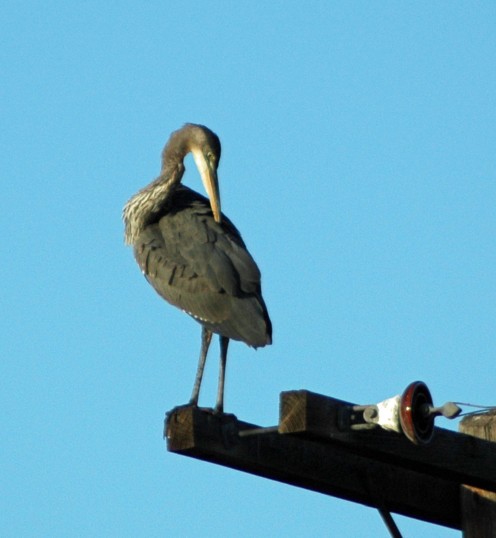
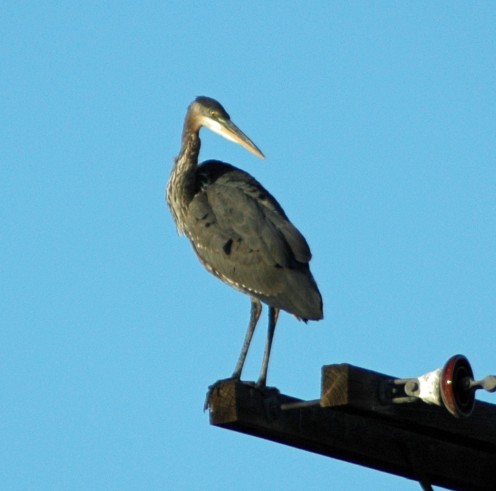
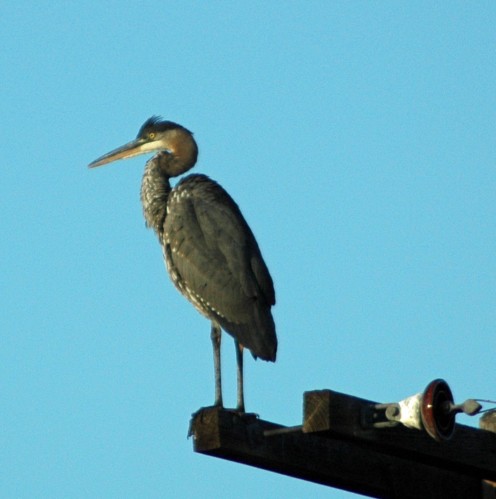
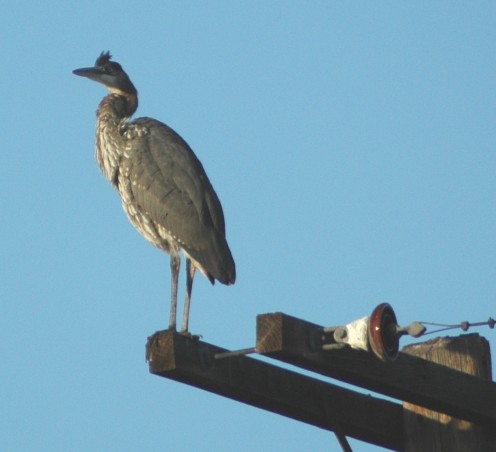
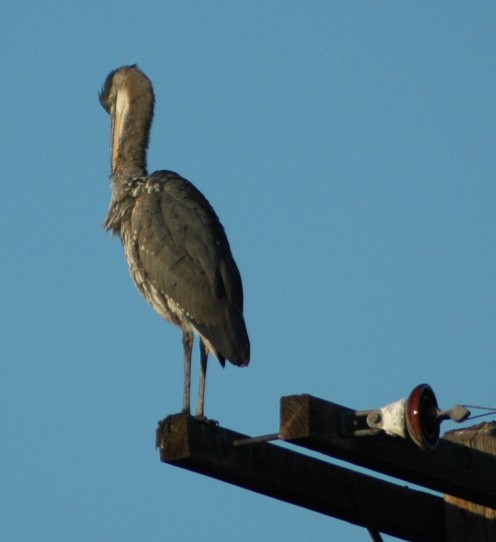
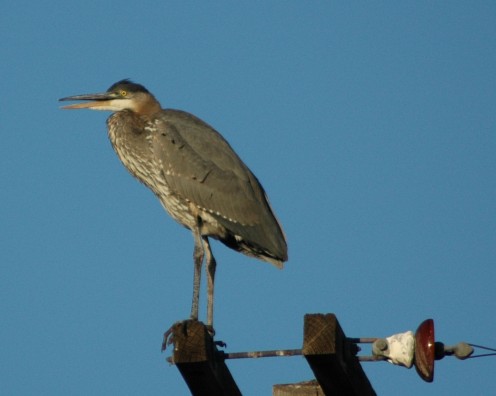
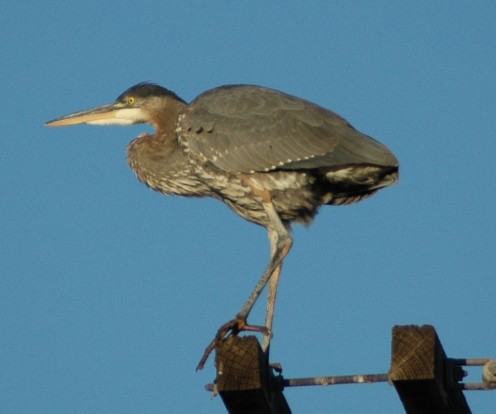
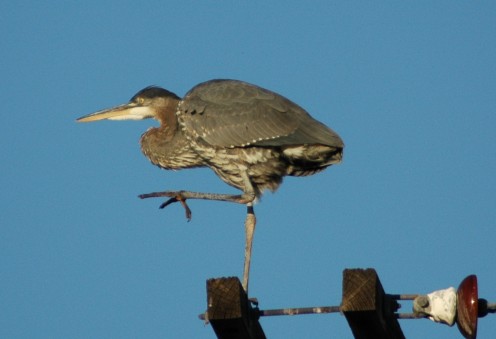
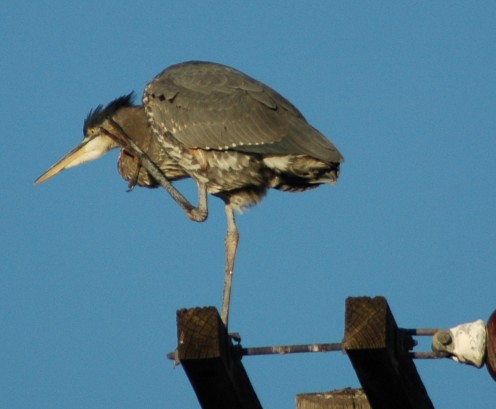
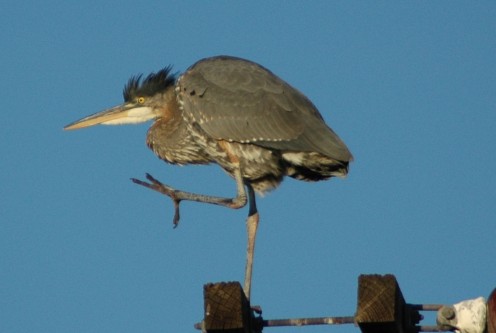
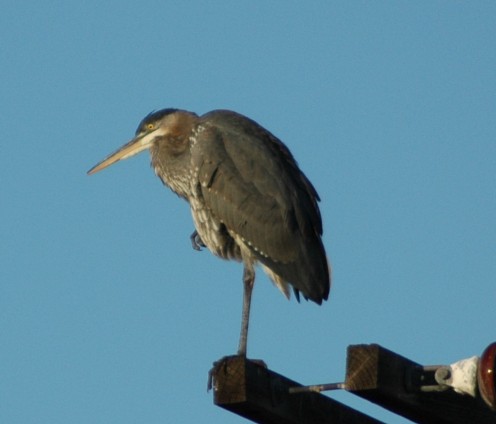
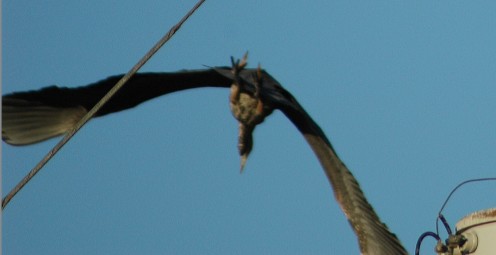
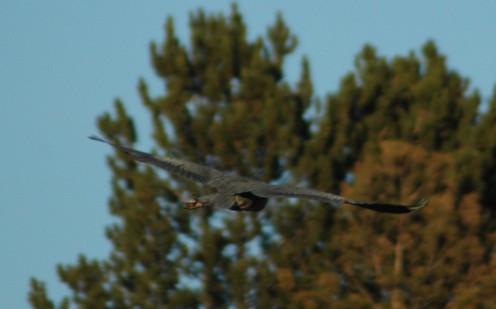
_________________________________________________________________
WHY DO THEY STAND ON ONE LEG?
There are two different theories raised as to why herons in particular stand on one leg at any given time. However, this behavior is not isolated to Great Blue Herons by any means as many different bird species regularly stand on one leg.
In the case of the Great Blue Heron, it is said that this behavior minimizes heat loss. Arteries in the bird carrying warmed blood into the legs are in close contact with the veins that return colder blood to the heart of the bird. So theoretically, the arteries warm the veins and by standing on only one leg, the bird reduces one half of the amount of heat lost through his legs which have no feathers to keep them warm.
Likewise, it is said that in the case of crane-like birds, they employ one-legged stances when fishing as it creates a shadow or a lack of shadow. The prey may or may not be fooled by this but it appears to work well enough that they regularly employ it.
It is also further surmised that their legs are so gnarled looking that prey may mistake one leg for a branch or a twig and not realize the clear and present danger of the beak looming above them.
_________________________________________________________________
MORE IN FLIGHT ANOTHER DAY
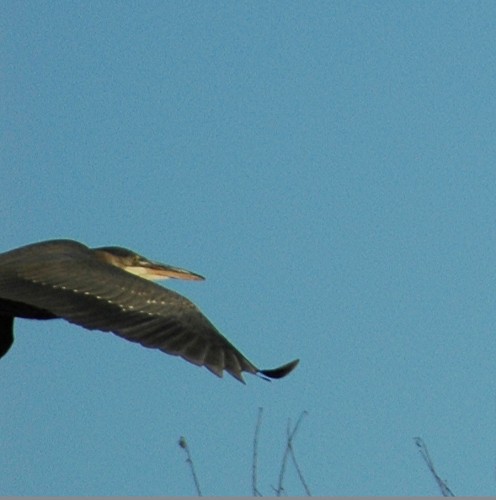
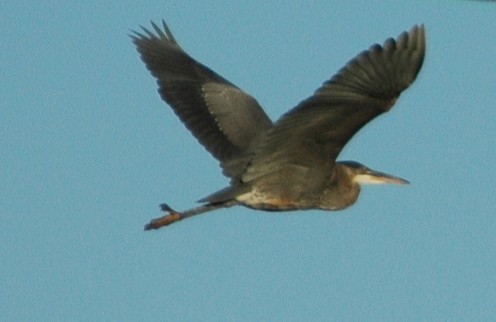
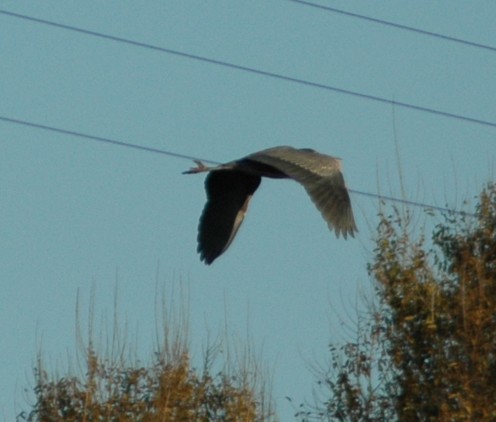
_________________________________________________________________
THE FUTURE OF THE GREAT BLUE HERON
Hopefully, the Great Blue Heron will be around for decades and centuries to come. However, it is worth noting that in the Pacific Northwest, their numbers have dwindled at a rate of 6% to 10% per year and it is being studied.
One factor heavily weighing in on the survival of the Great Blue Heron is urban sprawl. As more and more land is eaten up by asphalt, more and more trees are lost reducing the Great Blue Heron's habitat. As well, that is also impacting bald eagles and they are now one of the biggest threats to Great Blue Herons as they routinely rob their nests and kill their offspring or eat the eggs in the nest.
Another threat is the common black crow who usually come to the nests after the eagles have passed through. Since Great Blue Herons take such pains to nest high atop trees or cliffs, mammalian predators are not as great a threat though at times they have been known to kill adults but especially weakened offspring who have not mastered their survival skills.
Nothing is more majestic than seeing one of these fantastically awkward appearing birds land or take off. As the one video shows, it is as if they are ballet dancers performing the most intricate of steps on their spindly legs.
I hope to be lucky enough to get better pictures down the road in flight and otherwise. I could spend a lifetime photographing these incredible birds.
_________________________________________________________________
More Photo Galleries by This Author
- Photo Tour Of Barnes Butte IronHorse Trail Prinevill...
Come share a hike along the newly opened Prineville Oregon IronHorse Trail to Barnes Butte. A little hard to find, it is well worth the effort for a couple of hours spent gazing at beautiful vistas. - How To Take Dog Photos: Digital Photography How To W...
Creating Great Dog Photos In today's world of digital photography, it's easier than ever to create great dog photos. You don't need to take a class or even read a book. All you need is a willing canine subject or two, a camera and you're set to... - Dog Photo Gallery About Alaskan Malamutes
Alaskan malamutes are one of the oldest breeds of dogs and one of the most challenging to raise. A dog photo gallery of Alaskan malamutes and their wonderful personalities.
